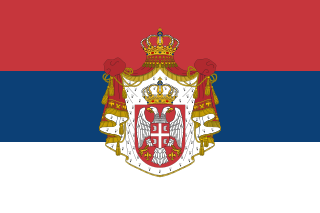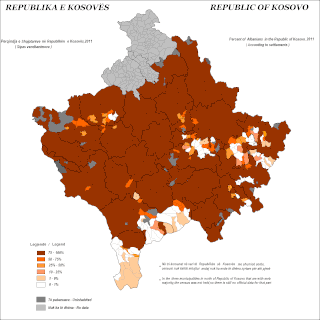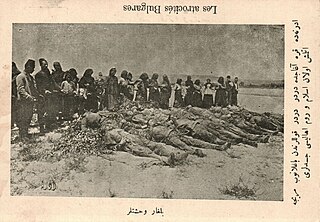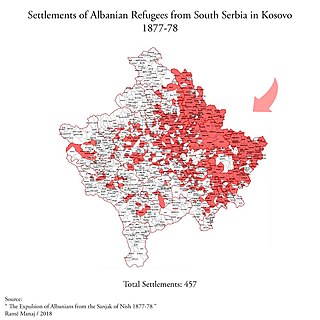This article includes information on the demographic history of Kosovo.

Prokuplje is a city and the administrative center of the Toplica District in southern Serbia. As of 2022 census, the municipality has a population of 38,054 inhabitants.

The League of Prizren, officially the League for the Defense of the Rights of the Albanian Nation, was an Albanian political organization that was officially founded on June 10, 1878 in the old town of Prizren in the Kosovo Vilayet of the Ottoman Empire. It was suppressed in April 1881.

The Kingdom of Serbia was a country located in the Balkans which was created when the ruler of the Principality of Serbia, Milan I, was proclaimed king in 1882. Since 1817, the Principality was ruled by the Obrenović dynasty. The Principality, under the suzerainty of the Ottoman Empire, de facto achieved full independence when the last Ottoman troops left Belgrade in 1867. The Congress of Berlin in 1878 recognized the formal independence of the Principality of Serbia, and in its composition Nišava, Pirot, Toplica and Vranje districts entered the South part of Serbia.

Kuršumlija is a town and municipality located in the Toplica District of the southern Serbia. It is situated near the rivers Toplica, Kosanica and Banjska, southeast of Mount Kopaonik and northwest of Mount Radan. As of 2022 census, the municipality has a population of 15,905 inhabitants.

The Vilayet of Kosovo was a first-level administrative division (vilayet) of the Ottoman Empire in the Balkan Peninsula which included the current territory of Kosovo. The areas today comprising Sandžak (Raška) region of Serbia and Montenegro, although de jure under Ottoman control, were in fact under Austro-Hungarian occupation from 1878 until 1909, as provided under Article 25 of the Treaty of Berlin.

Medveđa is a town and municipality located in the Jablanica District of southern Serbia. As of the 2022 census, the municipality has a population of 6,360, while the town has a population of 2,993.
Muhaxhir and Muhaxher are Ottoman Albanian communities that left their homes as refugees or were transferred, from Greece, Serbia and Montenegro to Albania, Kosovo and to a lesser extent North Macedonia during and following various wars.

The Albanians of Kosovo, also commonly called Kosovo Albanians, Kosovan Albanians or Kosovars, constitute the largest ethnic group in Kosovo.
Albanians in Serbia are a recognized national minority in Serbia. According to the 2022 census, the population of ethnic Albanians in Serbia is 61,687, constituting 0.9% of the total population. The vast majority of them live in the southern part of the country that borders Kosovo and North Macedonia, called the Preševo Valley. Their cultural center is located in Preševo.
Rašica (Albanian: Rashica) is a village in the municipality of Blace, Serbia. According to the 2002 census, the village has a population of 183 people.
Pačarađa (Albanian:Paqarada) is a village in the municipality of Kuršumlija, Serbia. According to the 2002 census, the village has a population of 41 people.
Žegrova (Albanian:Zhegrova) is a village in the municipality of Kuršumlija, Serbia. According to the 2002 census, the village has a population of 49 people.
Prekadin is a village in the municipality of Prokuplje, Serbia. According to the 2002 census, the village has a population of 167 people. In 1878 after the Congress Of Berlin, the Albanian population was either killed by Serbian troops or deported by force to Kosovo, mainly to the region of Ferizaj but also in Klina, Pej and Fushe Kosova. Today, the Albanians in Ferizaj are called "Muhaxherre" which basically means muslim refugees.
Jasenica (Albanian:Jashanica) is a village in the municipality of Žitorađa, Serbia. According to the 2002 census, the village has a population of 989 people.
The Sanjak of Niš was one of the sanjaks of the Ottoman Empire and its county town was Niš. It was composed of the kazas of Niš (Niş), Pirot (Şehirköy), Leskovac (Leskofça), Vranje (İvranye), Kuršumlija (Kurşunlu), Prokuplje (Ürküp) and Tran (Turan).

The Serbian–Ottoman Wars, also known as the Serbian–Turkish Wars or Serbian Wars for Independence, were two consequent wars, fought between the Principality of Serbia and the Ottoman Empire. In conjunction with the Principality of Montenegro, Serbia declared war on the Ottoman Empire on 30 June 1876. By the intervention of major European powers, ceasefire was concluded in autumn, and the Constantinople Conference was organized. Peace was signed on 28 February 1877 on the basis of status quo ante bellum. After a brief period of formal peace, Serbia declared war on the Ottoman Empire on 11 December 1877. Renewed hostilities lasted until February 1878.

During the decline and dissolution of the Ottoman Empire, Muslim inhabitants living in territories previously under Ottoman control, often found themselves as a persecuted minority after borders were re-drawn. These populations were subject to genocide, expropriation, massacres, religious persecution, mass rape, and ethnic cleansing.
The events of persecution against the Serbian population occurred in Ottoman Kosovo in 1878, as a consequence of the Serbian–Ottoman Wars (1876–78). Incoming Albanian refugees to Kosovo who were expelled by the Serbian army from the Sanjak of Niš were involved in revenge attacks and hostile to the local Serb population. Albanian troops also participated in attacks, at the behest of Sultan Abdul Hamid II.

The expulsion of the Albanians, 1877–1878 refers to events of forced migration of Albanian populations from areas that became incorporated into the Principality of Serbia and Principality of Montenegro in 1878 after their initial expulsion from 1830–1876. These wars, alongside the larger Russo-Ottoman War (1877–78) ended in defeat and substantial territorial losses for the Ottoman Empire which was formalised at the Congress of Berlin. This expulsion was part of the wider persecution of Muslims in the Balkans during the geopolitical and territorial decline of the Ottoman Empire.










